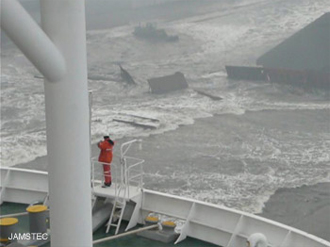

The landscape of Kitayama, KyotoSeptember 16, 2012
I am Yasuhiro, the logging specialist of this cruise. You may not know what logging is. This is a bit complicated story and I am going to tell you about it later on...
This is my second participation in Chikyu’s scientific drilling projects. The previous chance was her very first scientific drilling in 2007. We, the scientists and the ship crew, experienced many new things at that time because it was the first cruise. On board this time, I have felt everyone on the Chikyu is an expert in every field. A Japanese proverb, ‘feeling as if on a large ship’, can tell exactly how I felt as a sense of security and comfort. In fact, the Chikyu is a very large ship of almost 60,000 ton and extremely stable. When a typhoon hit the Chikyu in 2007, I even didn’t realize it because I was in a lab without a window to see outside. Surely we are always shaken a little bit, but I feel as if I were in a cradle and actually can sleep very well every night. The foods we can eat every 6 hours are always fresh and excellent, thus the on-board life is really comfortable.
I have been a company employee after my first degree in Geology. I wanted to know how the subjects I learned at the University are used in the real society. At a petroleum company as an exploration geologist to look for new oil and gas fields, I have found how earth science is useful for the society. Did you know the society is using earth science for exploration and development of energy and earth resources, because most of these are originally in the subsurface? I learned a lot from many specialists in the industry and gradually inclined to know more about earth science and use it to contribute to the society. This led me to my current status. With students, I am now polishing what I learned during my industry days, and conducting research to find out something new, and to apply that to something useful for the society. The participation on this cruise and contribution to such a state-of-the art science is very important for me to express my return to those who have been supporting me.
Now, I need to speak about logging. Original meaning of logging is to take log (record), but the log of this cruise means data. We dropped special sensors to the well we drilled, measured various data, and took underground water from subsurface rock. We call this operation ‘logging’. My task is to use the data to investigate the rocks in detail. This logging, as a measurement method, is commonly used in energy exploration industry, thus I am using my industry experience for this scientific drilling.
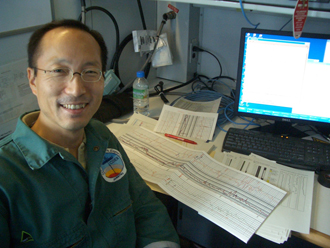
In the logging data acquisition unit. After a 12-hours measurement was completed successfully.
This expedition planned to take underground water from sub-sea rocks, but the million-year aged rocks are tough counterparts and didn’t allow our attempts easily. Several rocks became our targets after analysis on the logging data, then a special tool of water sampling went into the well. The rocks were however extremely soft and the fragments of rocks plugged the tool when we tried to squeeze water. We had to push and pull the rocks with the tool... Can you imagine that we had to have such a game with the underground rocks of the Pacific Ocean? After a long time of our persistent efforts, the rocks finally allowed us to take water. By analyzing this water, one more new side of the earth may be discovered.
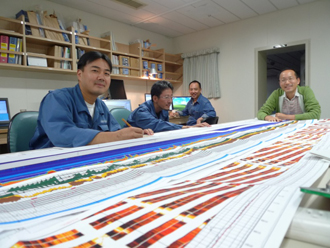
Logging data analysis by nice guys of staff-scientists
(Sanada-san, Nakamura-san, Moe-san) and myself (from left to right).
Log also means tree trunk (Maruta in Japanese). You may have seen or heard ‘log-house’. There is a street named ‘Maruta-machi (Log town)’ in the south of the imperial palace, Kyoto. Where the street crosses the Kamogawa-river, we can see the landscape of the Kitayama (north hills), which is my favorite. I recall this landscape to refresh my brain, and listen in to the story of million-years ago that the data tells.
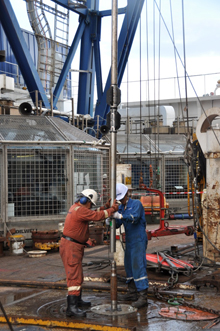
One of the logging tools is going into the well.


Health Comes First!September 14, 2012
To enrich our Chikyu life, Health Comes First! Ship makes you think of seasickness, though almost no researcher gets seasickness as we find no rocking to the ship. Someone says that it is easy to come to seasickness when you examine core samples with a microscope, but I have never done this before. (Actually, Doris told me she felt bad during microscopic observation.). A two month voyage is long enough to get out of our condition even we try to keep good in our health. One researcher got stomatitis (inflammation of the mucous membrane of the mouth), and it seems hard to have eating and even any conversation. Some complained other illness as well. My physical condition was normal during first 10 days, though our bowels became not to work well after that. I kept seeing how our bowels go though no sign of improvement. As last resort, I decided to run to the Hospital. I wonder what sort of place is the HOSPITAL. I entered with some tension, a woman who is apparently the nurse talked on the phone about ambulance transportation. I visited out of place? While I was waiting for her, she handed the medical checklist to me. After I filled out the form, she asked "what is the matter with you?" "Well, I, I feel like XX with XX, and etc." In a moment, she suggested I cut down on my meal. What? Did I eat too much? Seriously? Her medical advice was finished by prescribing a three-day supply of medicine. For that matter, examination was free of charge.
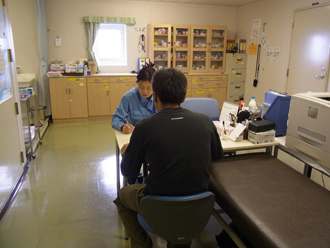
Scientist Ijiri-san is under medical examination in the hospital.
Hospital room reminds me a dear nurse's office in Japanese elementary school! Next to the hospital, plain admission room was settled with nothing but three beds. Nurse's room was also next to the hospital so as to respond to emergency cases very quickly. This room was located at the forefront in Chikyu, where is the best location for health! Chikyu health is supported by a great nurse. She works 12 hours every day with no holiday. She stays here for one month and then is replaced with another nurse. One month later, she comes back again after refreshment. Total of 6 months on the Chikyu is her life in a year. How hard she works for our health! Do you know what conditions is the most for the crews rushing into the hospital? The answer is a slight cold based on the nurse's impression.
We must keep wears clean every day from the point of health care. Big laundry-machine factory is provided downstairs in Chikyu to wash our clothes. When we have some wears to be washed, we put our wash in a special bag we were given. Then, we put bag on the floor in the front of the door of our cabin. In a few hours, the laundries are returned to the same place with pressing and folding up very neatly. What a wonderful system!
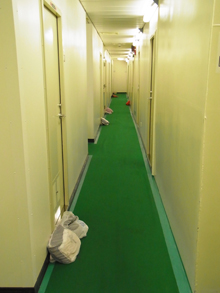
Clean wears returned from laundry room in front of the cabins
One day, I found the pen I preferred to write with was missing (the pen is a token of thanks for my cooperation with TV program). I looked for all over the Chikyu, but I could not find it. Oh, I might have put the pen in the pocket in jersey? I left the jersey as laundry just 20 minutes before. I hurried to be back to my cabin, it was too late. The laundry was already gone into the laundry machine. Several hours later, the wears were returned, but pen was still missing. When I was almost at a loss, I came across the laundry man in the elevator. I frantically explained about missing my pen as simple three words, Pocket! Pen! Inside! He asked, "Blue?" "Yes! Blue pen." He might have something in mind, and he told me he would return my blue pen to the cabin. I finally met my dear pen again.
Today, I found someone’s Mickey Mouse T-shirts in the returned wears. The T-shirt was piled up on my familiar Mickey Mouse T-shirt. The Mickey Mouse as twins!! I do not know why. Anyway, very thanks to laundry man. Oops, I have to return a twin to his mother. What should I do?
In this manner, our Chikyu life is fully supported by such staff whom we are not aware are in the background.
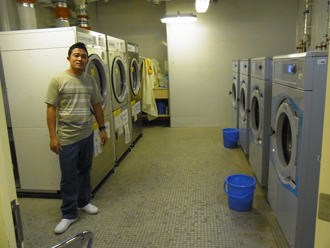
Thanks to Chikyu staff in the big laundry-machine factory


What do the Olympics and research with the drillship Chikyu have in common?September 7, 2012
The short answer is – world records!
Many of us, including me, were among the many spectators worldwide who enjoyed the 2012 summer Olympics – a one-of-a-kind sports event featuring world-class athletes exhibiting superhuman abilities and, often, breaking world records and making new ones. Watching the competitions, I was often surprised that athletes continue to improve their speed and skills in running, swimming, jumping and so on, and beat world records by a few millimeters or hundredth of seconds.
Just a few days after the Olympics closing ceremony, I traveled to Japan to participate in IODP Expedition 337 and study microbes chewing on layers of coal buried deep underneath the seabed in the Pacific Ocean. The vessel we are sailing on is the largest ever built for research – the majestic vessel Chikyu. I have sailed two times on a similar drilling vessel – the JOIDES Resolution, and I very much enjoyed the experience. But the Chikyu is in an entirely different weight class, not just in terms of size, comfort, and laboratory space, but also in its ability to cross research frontiers and, ultimately, to break world records.
And this is exactly what we just witnessed - the world record of drilling the deepest hole in the history of scientific ocean drilling. Last night we surpassed the record depth of 2,111 meters underneath the seafloor, a record made by the drilling vessel JOIDES Resolution in 1993 off Ecuador.
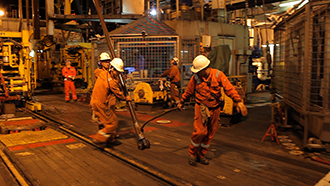
Core on deck – the world-record core is delivered to the cutting area where we scientists are waiting (photo: Luc Riolon).
It was a great moment at around 3 in the morning on September 6 when we received the record core that nearly touched the 2120-meter mark from the rig floor. We were all overjoyed, and very proud, to be viewing samples so valuable and unique for science, taken from a depth in the earth never before reached by scientific ocean drilling. If champagne were allowed onboard the Chikyu, we certainly would have opened a bottle.
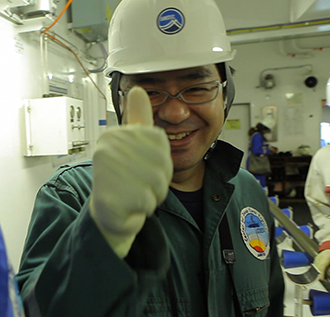
Fumio Inagaki, co-chief scientist of Expedition 337, gives the thumbs-up to the first core brought up from the scientific world-record drill (photo: Luc Riolon).
The best Olympic athletes regularly increase their performance in small increments, but it appeared effortless for the Chikyu to penetrate the deepest barriers ever drilled before. This research vessel is poised to dramatically push the boundaries of Earth Sciences, and we will definitely see it breaking many more records in the years to come. These records won’t just be mere extensions of drilling depth; it is this ship’s capacity paired with the imagination of the vibrant international scientific ocean drilling community that will break records in our understanding of this planet.
We may witness another world record in the near future: the Expedition 337 team still has the chance to find the deepest life ever encountered below the seafloor. But our world record in drilling depth may just be short-lived: the target drill depth of the next Chikyu expedition during the next few months at the Nankai Trough is 3.6 km.
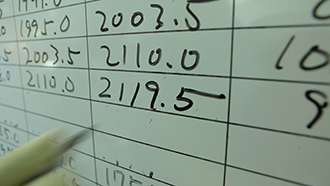
The coring depth is recorded in meters below the seafloor (photo: Luc Riolon).
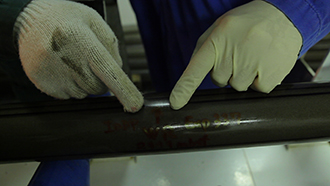
Fumio Inagaki and Kai-Uwe Hinrichs pointing to the core interval that marks the world record (photo: Luc Riolon)
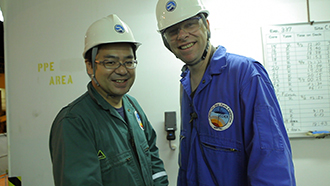
Very happy! (Co-chief scientists Fumio and Kai; photo: Luc Riolon)


Core, Flag and SunriseSeptember 3, 2012
Good morning, today is 00.30 in the morning Chikyu time. The first September 2012. Time running so fast, it’s already our 36 days in the Chikyu. In this expedition I am assigned as sedimentologist. It’s always exciting for me to start my working shift and wondering what kind of core we will explore tonight. My shift starts from 00.00am in the morning until 12 noon time. Today, I have a very good sleep, feel fresh and ready to explore the core.
Originally I am from Indonesia but currently I am studying at University of Queensland Australia. It’s only 1-hour difference between Brisbane and the Chikyu, with Brisbane ahead. While in the beginning I need sometime to adjust my bioclock for the nightshift job, now I just feel it’s definitely fine. In fact, I feel lucky to be in the night shift as I have the opportunity to enjoy fresh air in the morning and of course sunset almost every day.
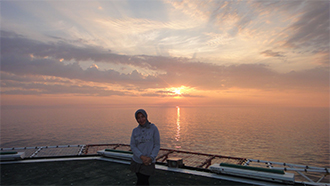
There are 3 sedimentologists working in each shift. Our group primary responsibility is to describe the lithology and stratigraphy of sediments and sedimentary rocks both in cores and cuttings as well as provide a written interpretation about the geologic history of the drilling site from the lithological perspective.
Other than working as shipboard scientist, we also pursue our own scientific interests and assist with other scientific duties in this project. For instance, my particular interest in this project is to compare the Indonesian, Australian and Japanese Tertiary coals bioavailabilty potential for the future natural gas regeneration.
Before the cores lying in our description table, actually they have quite a long journey. It need approximately 3-4 hour before they are ready to be analyzed in our table. In general, once they arrived on deck, the core will be cut every 1.5 meter, go for XCT scan, and then will be cut whole round for microbio and interstitial water samples.
After the completion of these whole-core analyses, the core sections (1.5 meter length) are carried into the core splitting room, where they are halved lengthwise by the lab technicians into 2 split cores, working half and archive half.
The archive half is the one that taken to sedimentology laboratory for visual description while the working half is taken to the sampling table, where the curatorial representative oversees the collection of samples for shipboard and shore-based scientists analyses. Our description table is equipped with 8 flat core racks about 2 meter long, meter sticks, and overhead track lights.
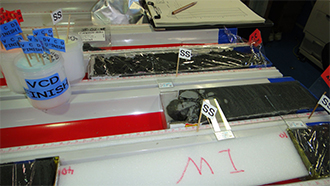
Our principal task of the shipboard sedimentologists is the layer-by-layer description of the sediments or sedimentary rocks within the cores. We will record our description on the Visual Core Description form. In our routine work, first we need to define layer on the basis of variations in its sediment lithology, color, sedimentary structures, or other specific characteristics.
After that, overall on each core we will observe: the thickness and attitude of sediment layers, structures, bedding planes, lithology, color and degree of disturbance by the drilling process. We also need to make smear slides or thin section and analyzed them under the microscope in order to do lithology checking.
In this expedition, sedimentologist is also helping the curator preparing all the requested samples both for shipboard or shore based analyses. As a sedimentologist, our world is full of flags. Flag for taking samples for shipboard analysis, flag after finish our visual description work or flag for taking personal samples.
Don't think these are as big flags, just tiny flags of printed paper glued into the toothpicks. I like to see many flags placed on the core sample cut in half, some of the flags with the nice picture of the people who requested the samples. It’s just so cool to have our own flag. I think I will bring home my own flag and will ask one of my colleague’s flag for memories as well.
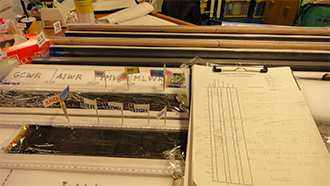
After several hours work, we will have a nice sun rise break... usually we go to the helideck, enjoy the fresh morning air while watching the sunrise... it’s just a wonderful moment.
Later when I am going back to my routine life, something that I will always remember from this expedition is “core, flag and sunrise”... It’s definitely one of my delicious menus in the Chikyu life.


Thinking while measuringSeptember 1, 2012
Hello, folks! We just turned at the corner of the halfway mark of our Expedition 337. The scientists are all busy at work in the lab, handling and processing the sediment samples that the CHIKYU has recovered by its drilling system. I’m, of course, one of them!
Every 12 hours of the night shift, I’m absorbed in measurements in the lab. What am I measuring? Maybe next time, I’ll tell you if I can have time to. In fact, I was very much looking forward to attending this CHIKYU expedition operating in this area off Shimokita, because the area is very attractive in a geological sense.
For the last few years, I have looked into geologic structure below the seafloor in this area, and, I’ve discovered the fact that huge submarine landslides have occurred repeatedly for the last few million years. This is an unbelievable fact! Because the seafloor here is very flat and spreads wide and almost horizontally, at less than 1 degree in gradient. Maybe, no one expects huge submarine landslides occurred in this area at first glance.
Using the latest seismic surveys, a number of submarine landslides have been identified one after another, all over the seven seas. And, they have come under scrutiny because they sometimes trigger tsunamis or cut off submarine cables, but, the pattern of submarine landslide is quite varied. The cause of ground instability under the sea still is poorly understood. On land, after a heavy rain, the ground water level can change. This sometimes makes the ground unstable and may lead to a landslide at a mountain slope.
On the other hand, how about the sub-seafloor? Seafloor sediments are all the time filled with water. I hope you understand the on-land system doesn’t simply work under the sea. And, the Shimokita area’s seafloor is almost horizontal.
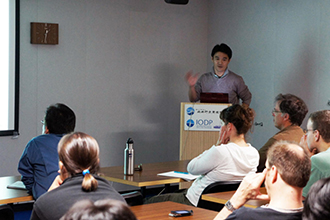
Talking about geological background of the drill site at science meeting.
So, you might think it’s odd that I, who works to investigate submarine landslides, should attend this expedition, named “Deep coalbed biosphere”. It’s because characteristics of the geological formation in this area may be a key to approach this issue.
According to the structural analysis using seismic methods, the ground instability causing submarine landslides has proved to be related to natural gas, one of the major themes of our expedition. However, the gas is not thought to be large enough to be considered an available resource at this moment. And, landslides of this magnitude have not yet occurred during our lifetimes.
As one of my studies here, I’m trying to figure out past thermal conditions of the sediments. Temperature is very important parameter for status of gas and water in the geological formation, and for microbial activity as well. According to microbiological study, there might be a tremendously huge amount of microbial activity in this area. Microbes sometimes contribute to the process of natural gas formation. Thus, such an uncommon environment might be ultimately related to the ground instability leading to submarine landslides, shouldn’t it? Considering such speculation, I am absorbed in the lab measurements tonight as well...
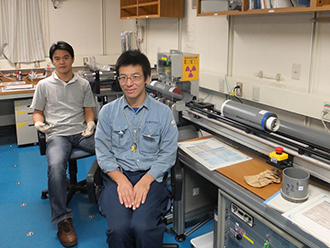
Working on multi-sensor core logger (MSCL: right behind) with Mr.Takahiro Suzuki (front),
one of the excellent lab technicians.


“地球号”上的“乒乓球世界锦标赛”August 27, 2012
随着BOP的安装、检测和各項科学实验计划的顺利实施以及实验样品的顺利采集,地球号上的一项重大赛事——“337号航海第一届乒乓球世界锦标赛”于8月12号拉开序幕一直举行到9月5号。共有来自8个国家的23位科学家选手参加。本次比赛本着娱乐第一,成绩第二的精神,自觉遵守比赛规则,以及协商选择裁判和自由挑选比赛时间的原则。根据每位科学家的工作时间,比赛分为两个半区,上半区由白天工作人员组成,共有12位参赛选手,下半区由晚上工作人员组成,共有11位选手以及1名来自首轮比赛输掉选手中再次比赛获胜的选手。每个半区又按报名顺序決定分组,每区的第一报名者为种子选手直接参加第二轮比赛。本次锦标赛采取非常正规的国际规则,每项比赛以11分获胜,5局3胜。为了给每位选手更多的比赛机会,首轮输掉比赛的选手将自动组成新的一组。多轮比赛后排名第一的选手才有机会与下半区选手争夺决赛权。最后白天组和晚上组的排名第一的选手争夺本次比赛的总冠军。到目前为止,比赛仍在进行,….
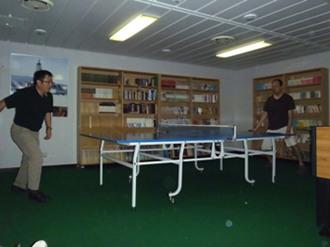
本次比赛不分年龄,不分男女,一视同仁,每个人都有平等的机会。几乎所有人都参加了比赛,包括首席科学家Inagaki博士,Hinrichs博士以及首先项目执行官Kubo博士。其中有像我这样打过几天的“老手”(48岁),也有从未打过的“新秀”。有些有着“光辉的业绩”,来自Rice University的Snyder博士非常自豪地告诉我们:“他从来就没有输过”,正当我们还在吃惊之际,他又说道:“因为他从来就没有打过乒乓球”。当然,他的个人记录已经在“地球号”上被打破了!
样品要来了,我也需要离开了,祝愿“地球号”“第一届乒乓球世界锦标赛”圆满成功!不管谁是第一,我们都是最好的,因为我们参加的是前所未有的,举办在“地球号”上的国际比赛。
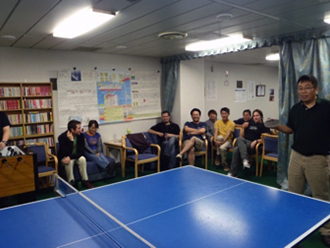
Along with the BOP landing, detecting and the successful proceeding of each scientific project as well as the samples arriving at our desk, one of the most fun international games “EXP. 337 the 1st Ping Pong World Championship” has been held at Chikyu from Aug. 12 to Sep. 5, 2012. There are 23 scientific players from 8 countries participating in this game. From what point of view, the basic principle of this game is: entertainment comes first, winning comes second. Following the rules, players can freely choose their judge and match time. The tournament has two groups of players based on the working shift of the scientists, the day shift group contains 12 players and the night shift group has 11 players and one player from the group which lost their first match. The matching in each group is decided randomly mainly based on the sign-up order and the 1st sign-up automatically is a seed player to join the 2nd round match. Very formal match roles were applied in this international competition. Each match was to be played to eleven points. The player who could win 3 out of 5 games first would be the winner of the game. In order to allow each player to have more chances, the ones that lost in the first game could automatically come to a new group. After several heated match, only the player that ranked at the 1st place would have the chance to come to the night shift group to compete in the semi-final match. Finally, the players that ranked at 1st place from each shift group could go to the final competition. The competition is going right now.
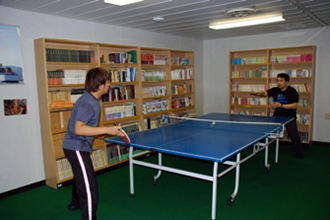
It is a game of piece with no gender and age restrict, and everyone has equal opportunity. Almost all of the science party members participate in this game including the co-chiefs Drs. Inagaki and Hinrichs, and the expedition project manager Dr. Kubo. Some of them have some experience because of seniority such as me, who is 48-years old; some of them are “new stars” for they might have never played this sport before. Some of them have an excellent history record of Ping Pong, such as Dr. Snyder from Rice University, who claimed to have never lost a game before. When we were amazed by his record, he told us: “because I’ve never played Ping Pong game”. Of course, he has already broken his personnel Ping Pong record on the Chikyu.
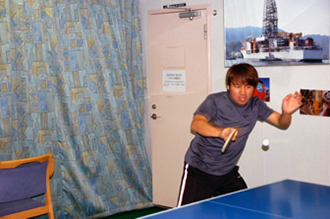
Samples are coming and I have to go. I wish “The 1st Ping Pong World Championship” on the Chikyu a success! No matter who will be the No. 1, we are the best, because we are all participating in the Chikyu international expedition, and such expedition that has never been held before.


Methane, Microbes, and MarsAugust 24, 2012
While methane gas is not a major component of the Earth’s atmosphere today, billions of years ago it helped to keep our planet from freezing when our sun was not as bright. Today our sun is much brighter. If we add more methane to the atmosphere, its ability to trap heat can contribute to making the planet even warmer than it is now.
My work onboard Expedition 337 includes looking deep sea microorganisms that are able to eat methane before it can escape to the atmosphere. Microorganisms have many special adaptations to be able to live deep down where there is no light, no oxygen, and very limited nutrients. For example, the ones I study make the work easier by sharing the load between two different forms of life: Archaea and Bacteria. Archaea and Bacteria are as different from each other as we are from them - and they are just single cells!
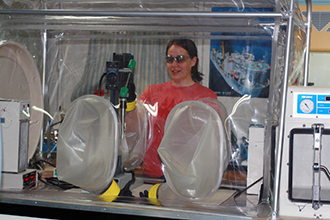
Anaerobic glove box in microbiology lab on the Chikyu.
No oxygen in here, which is more preferential condition for deep life than the air.
We know that they have evolved a way to make a living off methane by working together, but exactly how they do it is still a great mystery. I will be collecting samples on this cruise where methane consuming, or methanotrophic, microorganisms are most likely to exist in the sediment cores we bring onboard.
I will take the samples back to my research lab and keep them sort of like pets. I will give them the temperatures, foods, and nutrients I think they will like to see if I can find microbes that will eat methane. I will do this by adding a special kind of methane that I can track. If this special methane is eaten, I will see it stored in parts of the cell when I put them under the beam of a machine that gently strips away atoms and tells me what kind are there (called a NanoSIMS). These samples come from low energy environments, so even with partner microbes, they still grow very, very slowly. This means I will have to wait many months to years before I know if my experiments worked.
Studying how microorganisms are able to use methane in an environment with no oxygen and little nutrients also matters to scientists looking for life beyond our planet, Earth. While onboard I have been following the progress of the Mars rover Curiosity that just successfully landed. Many of my friends and coworkers at my home institution, Caltech, are involved in this mission and were very happy to see it landed safely and begin sending data back to Earth. One of the main missions for this rover is to look for possible signs that life could have existed (or does exist!) on Mars. Our work to study the limits of life in the deep subsurface of the Earth is helpful for understanding what may be possible on other planets. I am very excited to see what we will find and look forward to sharing the results of our special mission.
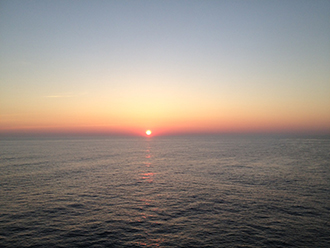
Enjoying a beautiful sunrise before lunch on the night shift.


Smalls in the deep mudAugust 20, 2012
Good morning! It is 4 a.m. and almost time for lunch.
As Ms. Marcella Purkey stated in her report, we have two work shifts since the “Chikyu” is under operation 24 hours a day. I, a night shift guy, have been sleepy during this early morning time period because of “jet [not actually jet] lag”, though I’m now gradually getting used to it.
By the way, today’s report is about subseafloor microbiology. Seafloor lies more than a kilometer away from our feet at current site, and below the seafloor, that is the world where we are looking at.
What do you imagine when you see the word “microbe”? Ticks? Water fleas? While these organisms are in the small size range of 0.01 to 0.1 mm, that is still “large” for us microbiologists, and we don’t usually see such big guys in subseafloor sediments.
Our target microbes have a size of around 0.001 mm, like the lactic acid bacterium that produces yogurt by fermenting milk. Microbes tend to have a bad reputation for rotting stuff or causing diseases, however, microbes also produce antibiotics to keep you healthy and help you digest your food. It is not an exaggeration to say that we cannot live our life without microbes.
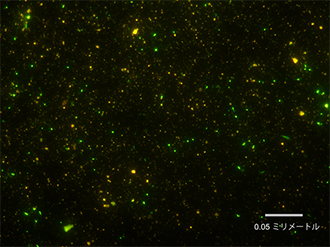
Subseafloor microbes (green dots) viewed through a microscope look like stars in the night sky.
Only microbes are able to live in the subseafloor. We estimate that there are about 10^30 cells (1000 billion billion billion cells!!) per cubic centimeter living deep down below the Earth’s surface.
1,000,000,000,000,000,000,000,000,000,000!
(Additional comment) Through the previous counts of subseafloor microbes, now we know that there are 1000 to billions of the cells per cubic centimeter below the seafloor By extrapolating this number to the whole subseafloor on the Earth, Whitmann et al. got an estimation of 10^30 microbial cells in subseafloor realm.
In this expedition, one of our missions is to find microbes in the deepest subseafloor core samples ever drilled. Are there microbes that deep? No one knows yet. Like the Mars rover Curiosity’s mission to explore for signs of life on Mars, we are going to look for life deep into the Earth.
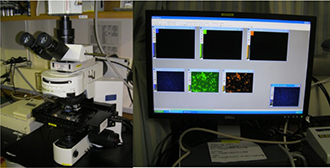
DiCE (discriminative cell enumeration) system for automated microbial counting
Since microbes are so tiny (about 0.001 mm), we cannot see them with the naked eye. We have to use microscopes to see and count them. These microbes are also very different from the ones on the Earth surface we can easily grow in a lab, so we have to find ways to study them directly from the sediment where they live. This can make cell counting very difficult because we have to distinguish between what is a sediment particle and what is a microbe. We sometimes miss small cells and have to take frequent breaks. So we decided to give this work to a computer named “DiCE”, shown in the picture above.
It doesn't need breaks and can tell the difference between cells and sediment automatically. All the analyses are recorded as pictures, so that we can come back later if we find some weird stuff that needs to be looked at again. This means we can constantly produce professional cell counting data throughout our expedition.
What microbes are living there? How are they making a living? How harsh of conditions they can stand? There are many mysteries in the subseafloor biosphere. Counting cells is just the beginning, but a very important step on the journey to understand the world below our feet.


Of tiny things ...August 18, 2012
You have read about all the big advantages and giant tools that are used onboard Chikyu for our exciting expedition. And indeed, they are breathtaking! They’re full of high-end technology and sophisticated engineering.
But on Chikyu, not only the big things are high-end technology. Also the little, tiny things require more advanced technology then you would ever imagine. Today, I will tell you about balancing (and not only because Libra is my zodiac sign).
During the last days, I spend hours by hours in weighing several hundreds of tiny glass vials that I will need later on for my experiments. Meanwhile, the balance and me, we became good friends.
You might now think “Uh, weighing... how boring...”, but let me tell you, a balance on a ship, that is high-end technology! Have you ever thought that balancing on a ship might be a tremendous challenge? You probably think, “What’s about? You step on the balance, wait until the pointer stops moving, you read the weight, and that’s it!” But what if the pointer does not stop? What if the ground and everything is in permanent movement? Like on a ship. Up and down, up and down. On the one moment your weight seems to be heavier and on the next it is much lighter. How can you measure a tiny weight with high precision under such circumstances?
The answer is as simple as highly sophisticated. You need two balances! And a good software that synchronizes them. On the one balance you put a “reference” weight, something of which you exactly now the weight. On the other balance you put the thing you want to measure. Next, you tell the software to start measurement, and the computer records the weight and all the periodic weight-changes produced by the movement of the ship for about one minute. By comparing the measurement signals of the two balances, the software eliminates the weight fluctuations. Once calculation is finished you get the weight presented on the screen with high accuracy and precision. That, I think, is a sophisticated solution to a problem that you probably not have suggest being one. And this is just one example out of many tiny things that are different on a ship than on shore and that require very special solutions.
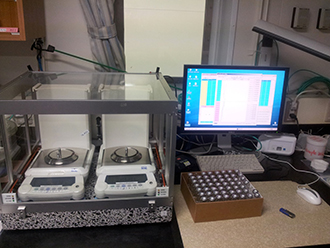
The picture shows the two balances, located in a glass box to avoid disturbance of the measurement by air draught.
On the right side is the computer monitor and in front of the monitor you see some of my hundreds of glass vials ready for weighing.


Safety DRILL on the ChikyuAugust 15, 2012
Around 10 minutes before 10:00 a.m. on every Sunday, all researchers and ship staff come together - fully-armored with personal protective equipment such as coverall, safety goggle, safety shoes, gloves, and helmets and life jackets. It's time for evacuation "drill".
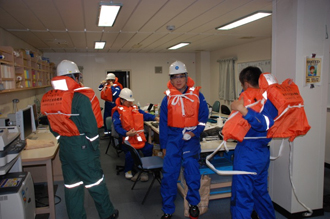
Scientists fully prepared for the drill.
The emergency alarm rings and then everybody heads to their assigned life boat. Next to each life boat, we find the "T-card muster station". After turning our T-card to signal our attendance, we line up in an orderly manner. There are evenly spaced yellow dots painted on the deck and each person gets to stand on a separate dot. This makes counting people and identifying absent people easy. If someone is missing, then life boat crews will search people still inside the ship. The reason why we are not allowed to lock the doors of our cabins now becomes clear: it is to avoid getting left behind in case of emergency.
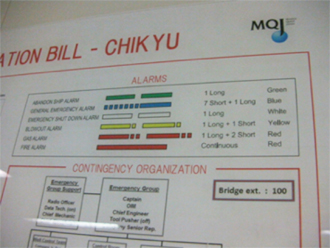
We can know what kind of accident occurs from patterns of ringing alarm.
It looks like Morse code.
Based on cabin number, people are assigned to life boats at starboard or portside. Three life boats are deployed on each side with capacities of 50 to 75 persons, depending on type. Assuming that the Chikyu can carry 200 persons at the maximum, that is too much. Do you know why?
The reason is that we all have to be able to evacuate from one side if the other side is not available. This would be the case if the ship lists to one side, or fire breaks out on one side. The Chikyu is very stable and we tend to almost forget that we are at sea. But safety awareness and safety drills are nonetheless very important, as becomes clear in the next paragraph.
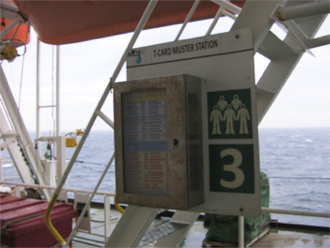
You have to turn around the T-card in box when you arrive at the muster station.
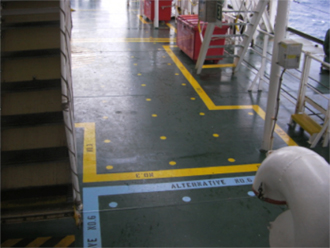
After turning the card, you have to line up on the dots.
Those are not just cute dots pattern but play significant role in emergency.
It was 4 days before the originally scheduled expedition departure, March 11, 2011, that we were busy setting up instruments and laboratory environment on board. Suddenly we felt a strong jolt, heard an emergency alarm, and saw a tsunami coming over a sea wall. It was not a situation to evacuate outside by life boats, so we gathered in a room on the upper deck. Due to the quick and nerveless evacuation no one was injured but I heard afterwards that the Chikyu turned around in the small port, was damaged and had been in a dangerous situation.
The "DRILL" we do every week leads our quick and safe act in case of emergency.














